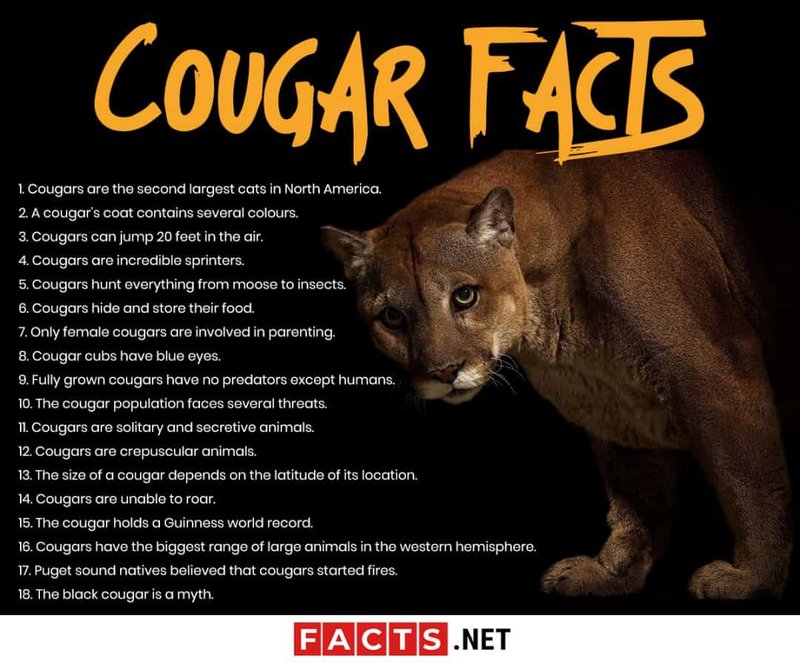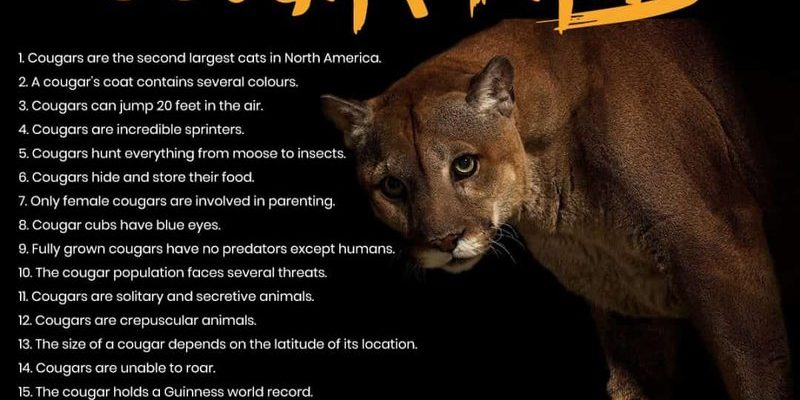
Cougars are often found in the mountainous and rugged terrains of North and South America. Their adaptability is amazing, allowing them to thrive in diverse environments—from forests to deserts. So, let’s dive into some fascinating facts about this incredible animal that might surprise you.
1. Cougars Are the Most Widespread Wild Cats in North America
Cougars have a vast range, stretching from Canada down to the southern tip of South America. You might think of them as only inhabiting the Rocky Mountains, but here’s the thing: they can also be found in forests, grasslands, and even urban areas. Their flexibility in habitat choice is one of the reasons they have thrived despite being hunted in the past.
What’s fascinating is their ability to adapt to human encroachment. Cougars can sometimes be spotted near suburban areas, looking for food. Just imagine a big cat casually strolling through your neighborhood, blending in while still being a master predator!
2. They Have a Silent Communication Style
While many animals use sound to communicate, cougars are often silent. Instead, they rely on body language and scent marking to express themselves. You might be wondering how they communicate at all—it’s clever! They leave scent markings on trees and bushes to let other cougars know their territory.
What’s even more surprising is that when they do vocalize, it can sound quite eerie. They can make a range of sounds, like screams, growls, and even purrs. Think about it—you’re hiking in the woods, and suddenly you hear a scream. That would definitely make your heart race!
3. Cougars Are Masters of Stealth
Cougars are built for stealth and power. Their long, muscular bodies and large paws give them the strength needed to pounce on their prey silently. They can leap up to 40 feet in a single bound! Imagine trying to dodge a big cat that can suddenly leap right in front of you.
They often hunt at dawn or dusk, using the low light to their advantage. Cougars typically stalk their prey—often deer—getting as close as possible before launching an attack. Their strategy is like a game of hide-and-seek but with higher stakes.
4. Their Diet Is Quite Varied
You might think of cougars solely as deer hunters, but their diet is surprisingly diverse. Cougars can eat anything from small rodents to larger animals like elk and bighorn sheep. They are opportunistic feeders, meaning they will take advantage of whatever is available.
One interesting aspect of their diet is their ability to take down prey larger than themselves. For instance, a fully grown cougar can bring down an adult deer, which is a significant challenge. This is because cougars are skilled at using their strength and stealth to ambush their prey effectively.
5. Cougars Have Unique Physical Characteristics
The physical traits of cougars set them apart from other big cats. Did you know they can weigh between 64 to 220 pounds and are typically 3 to 5.5 feet long? Their distinctive tawny coat helps them blend into different environments.
Another fascinating feature is their tails, which are about a third of their body length. This tail isn’t just for show; it helps them maintain balance while climbing or making sharp turns during a chase. Just picture a powerful cat deftly maneuvering through trees and rocky terrain.
6. They Are Solitary Animals
Unlike lions, which are known for their prides, cougars are solitary creatures. This means they prefer to live and hunt alone rather than in groups. They establish large territories, which they mark and defend against other cougars.
However, don’t let their solitary nature fool you—cougars do come together for mating. After that, it’s back to their independent lifestyles. Imagine a cat that enjoys its “me time” and only seeks company when it needs to.
7. Cougars Are Highly Agile
Cougars are incredibly agile animals. They can run up to 50 miles per hour in short bursts. If you think of a sprinter, that’s a cougar zooming through the underbrush. Their agility allows them to navigate tricky terrains, chase after prey, and escape threats efficiently.
Their climbing ability is also notable. Cougars can easily scale steep cliffs and trees, making them versatile hunters. When you see a cougar perched on a high branch, you can imagine it surveying its domain, ready to make a move.
8. They Play a Crucial Role in Their Ecosystem
As apex predators, cougars significantly impact their ecosystems. By regulating deer populations, they help maintain a balance in the environment. Fewer deer lead to healthier vegetation, which benefits other wildlife.
In this way, cougars contribute to a thriving ecosystem. It’s almost like they act as nature’s caretakers, ensuring every species has a place. Without them, we would see overpopulation of prey species, which could lead to habitat degradation.
9. Conservation Status
While cougars are adaptable, they face threats from habitat loss and hunting. In some areas, their populations are stable, but in others, they are declining. Many conservation groups are working hard to protect them and their habitats.
Understanding the importance of cougars can help foster respect and support for conservation efforts. Imagine living in a world where these majestic creatures can roam freely without fear—what a sight that would be!
10. Cougars Have Several Names
You might know them as cougars, but these cats have a lot of aliases! Depending on the region, they might be called mountain lions, pumas, or even catamounts. Isn’t that fascinating? Each name reflects a different aspect of their identity, whether it’s their habitat or their physical attributes.
This diversity in naming highlights the cultural significance of cougars across different areas. It’s always interesting to see how animals are perceived based on local history and folklore.
In conclusion, cougars are fascinating creatures that play a vital role in their ecosystems and possess remarkable physical traits and behaviors. Their adaptability, agility, and significance in nature make them a species worth learning about and protecting. Whether you’re hiking in their territories or simply admiring them from afar, take a moment to appreciate the incredible cougars that share our world!

